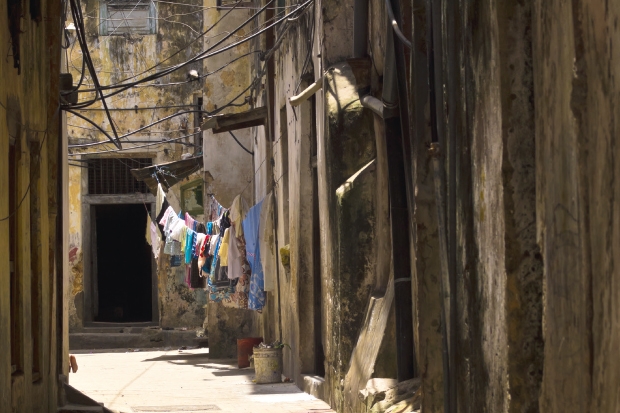Zanzibar has become a honeypot for honeymooners — with good reason. This exotic island is a mere six degrees south of the equator and is roughly 60 miles long and 25 miles wide. That means it’s toasty all year round, while being big enough for some exploration if you want it.
Its white beaches are stupendous, its people desperately poor but rich in spirit. The sea is a glorious turquoise, with plenty of coral reef for divers, and when the tide is out on the eastern side of the island, the horizon is dotted with women in bright kangas (wraps) wading through the water, scooping up chunks of seaweed that are later weighed and shipped off elsewhere, often to pharmaceutical companies in China.
What I especially love about the beaches around Jambiani, a small fishing village in the south-east — where, incidentally, the British charity Zanzibar Action Project (ZAP) is doing a wonderful job helping to educate the young and retrain the not so young — is that the hardened sand is really a busy thoroughfare. Men cycle up and down on their rusty steeds, children play hide and seek, tourists walk or jog, fishermen attend to their nets.
But what many visitors miss out altogether is Stone Town, the old part of the capital, Zanzibar Town, which has such a rich but haunting history that it warrants at least a night’s stay and, ideally, a full day in the company of a knowledgeable guide.
Sadly, some people have been put off by the horrific acid attack a couple of years ago on two gap-year students working as volunteers in a school, who were apparently guilty of little more than singing during Ramadan. But I have always found the locals friendly if not naturally effusive.
Zanzibar (population just over a million) is Muslim. And Zanzibar is complicated. It’s part of Tanzania, but is very much left to its own devices and has a fractious relationship with the mainland. Simmering tension is never far from the surface, as it has been for centuries.
In the 19th century, the so-called Spice Island was the most important trading hub along the whole coast
of east Africa, and was renowned for its shameful slave trade, which continued here for almost half a century after it was abolished in the British Empire.
This is not a comfortable thought when you’re taken down into an airless underground holding pen near Stone Town’s Cathedral Church of Christ, where the slaves awaited their fate in blistering heat. Missionaries later bought the site and immediately started building the cathedral, which opened on Christmas Day 1877, albeit without a roof. The altar is meant to stand exactly where there used to be a tree, to which slaves were tied and then whipped to show their strength and hardiness.
Essential reading while in this beguiling and mysterious city is Alastair Hazell’s superbly researched and beautifully written The Last
Slave Market. It tells the grim but inspiring story of a Scots doctor, John Kirk, who was sent to Zanzibar as a medical officer in the 1850s and ended up persuading Sultan Barghash to bring an end to the traffic in humans in 1873.
The Stone Town you see today is largely the creation of the Sultan of Oman, who in the 1830s moved his capital from Muscat to Zanzibar. It is a curious mix. Start at the meat market and you might switch to the vegetarian option for dinner — it is certainly not for the squeamish.
But wandering through some of the dilapidated old palaces and buildings is a chance to savour a forgotten world. The House of Wonders (so-called because it was the first building to have electricity) is unmissable, with its tiered balconies and multilayered history. It was built in 1883 as a ceremonial palace for Sultan Barghash and became the offices of the British colonial government from 1911 to independence in 1964.
The place to stay (though not cheap) is the Serena Inn, where at sunset local Taarab musicians entertain guests on one side of the sea wall and locals play a mixture of football and water polo on the other. There’s another option as of earlier this year, with the opening of the Park Hyatt Zanzibar, which is also on the beachfront, but I haven’t yet seen it.
There’s a touch of celebrity about Stone Town, too. Queen’s late front man Freddie Mercury (then Farrokh Bulsara) was born here after his parents had immigrated from India. When he was nine, Farrokh was sent to boarding school in India and never returned, but that doesn’t stop a number of bars and restaurants from claiming that ‘Freddie lived here’.
We got lost on several occasions but never felt intimidated. And there is nothing like the same sort of pressure to buy trinkets or the obligatory haggling that you find in the souks of Marrakech or Istanbul.
Mind you, the rule of law can be suspect. We rented a car and were soon pulled over by a lone policeman. I wasn’t wearing a seat belt, for which I was threatened with a visit to the police station followed — most likely, I was told — by some sort of court action.
The policeman and I both knew how this could be resolved; it was simply a matter of agreeing the price. After a lot of bartering, we settled on $10 in cash and he wished us well for the rest of our holiday.






Comments